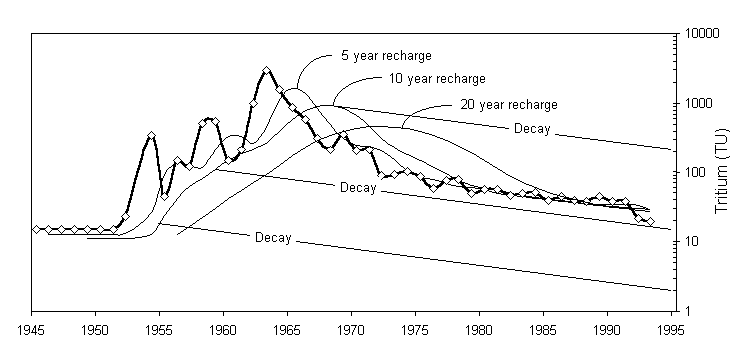
The tritium input function for groundwaters is more complicated than that measured in precipitation due to attenuation of seasonal variations and mixing of contributions from more than one year. The input is more complicated because the tritium from early contributions is decaying. Exponential modeling can be done to account for the differing 3H contributions during recharge, and the decay of 3H during this period of accumulation and mixing in the recharge area. One such model by Maloszewski and Zuber (Lumped parameter models for interpretation of environmental tracer data (supplementary annex) in Manual on mathematical models in isotope hydrogeology. IAEA-TECHDOC-910, IAEA, Vienna, 1996). This model can be downloaded here: .Exponential Model for Tritium
Consider a parcel of groundwater in a regional aquifer. In most cases
it is a composite of several yearsí precipitation which have contributed
to this water through mixing within the unsaturated zone, and by flow through
the recharge area where additions to the water table continually contribute
to the groundwater. Once this groundwater has moved into a confined zone,
or to depths where it no longer receives additions from the surface, itís
3H content will decrease by decay.
The 3H concentration in this groundwater
parcel will be a function of its residence time in the recharge environment.
The multi-year 3H input function
can be determined from: (1) the weighted contribution of 3H
from each year, with (2) a correction for the decay of each yearís precipitation
contribution during storage in the recharge area. For example, letís assume
that our parcel of groundwater accumulated over three years in the recharge
area, with 25% from year 1, 50% from year 2 and 25% from year 3. At the
end of year 3, when our groundwater moves past the recharge zone, its 3H
concentration will be equal to 25% of the 3H
level in year 1 precipitation times 25%, with 3 years of decay (5.5% per
year) plus 50% of the 3H in year
2, decayed over 2 years, plus 25% of year 3 3H
decayed over 1 year.
The input function for tritium in precipitation can be approximated by this approach, using a decay model of recharge that is essentially a smoothing calculation. The model assumes that each groundwater component along the flow system has received the same weighting of multi-year contributions from precipitation in the recharge environment. The weighting of each year is approximated by a normal distribution that puts the greatest weight on the precipitation from the central years, with lowest contributions from the first and last years.
Fig. 7-4 shows three recharge models for the annually averaged tritium
curve for Ottawa. The recharge curves are plotted for the year when the
groundwater becomes shut off from additional recharge. Increasing the number
of recharge years in the model attenuates the peak fallout level, and increases
inputs in post 1962 recharge relative to the input curve (1 year MRT).

Extrapolation from a measured value for groundwater sampled at a given
date to the most appropriate recharge input curve provides an estimate
of groundwater residence time beyond the recharge environment. For example,
lets assume that in 1995 we measured 2 TU in groundwater from an aquifer
with an estimated 10 year period of accumulation in the recharge area.
Back extrapolation along the bottom decay curve in Error! Reference source
not found. intersects the 10 year recharge curve at the end of 1954. Total
mean subsurface residence time would then be about 40 years plus the mean
residence time in the recharge area (about 5 years).
The MRT selected for the model depends on the hydrogeological setting
in the recharge environment. Systems with thick unsaturated zones and large,
unconfined recharge areas may mix recharge over 5 to 10 years or more before
a given groundwater parcel becomes closed to further inputs. In contrast,
systems with recharge regions of limited areal extent may have little mixing
in the recharge area. In this case, the recharge period may be less than
5 years.